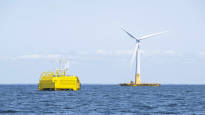Green hydrogen can reduce industrial emissions and can be used as an energy source. Finland is also expecting billions in hydrogen economy investments.
The production of renewable green hydrogen is possible at sea. It was proved by the French stock exchange company Lhyfe, which announced having completed its two-phase test successfully.
The world’s first green hydrogen producing pilot plant called Sealhyfe was first tested for eight months in the port of Saint-Nazaire before being sent to sea on May 18, 2023. The plant will float in the open sea and run on wind power.
The pilot plant operated at sea for six months in varying conditions, and now the technology is to be commercialized.
Lhyfe, based in Nantes, France, is one of the world’s pioneers in the production of green and renewable hydrogen. The company has also invested in Finland, which is aiming for billion investments in the hydrogen economy.
Get rid of emissions with green hydrogen
Hydrogen has been known as an energy source for over two hundred years. Hydrogen is mainly used in the chemical industry in the production of ammonia and methanol and in oil refining. Hydrogen is also a means of reducing climate emissions and storing energy.
Currently, most of the hydrogen used by industry is produced from fossil fuels such as natural gas, which produces a lot of carbon dioxide emissions.
However, hydrogen can be produced emission-free from water using electrolysis. In it, the water molecules are separated with the help of electricity into oxygen and hydrogen, from which the hydrogen is recovered.
When renewable energy, such as wind power, is used for production, the production process becomes completely emission-free. This emission-free hydrogen is called green hydrogen.
However, now comes the real steak of future hydrogen-based energy production: emission-free hydrogen can be stored as an energy source.
When the production of renewable energy, for example solar or wind power, exceeds the need for electricity consumption, the excess electricity can be used to produce hydrogen for storage. This stored hydrogen is used when solar or wind power is not available.
Then the entire energy chain is completely emission-free, because burning pure hydrogen produces no emissions at all. The only end product besides electricity is water.
Lhyfe’s technology is being commercialized – the company also has investments in Finland
Lhyfe’s pilot plant was powered by a floating wind turbine and was able to produce 400 kilograms of hydrogen per day with a one-megawatt electrolysis facility.
Last June, the company’s future project received a grant of 20 million euros through the European Commission program. The next step is the commercialization of the technology and a ten megawatt production plant that would produce four tons of hydrogen daily.
Lhyfe has also made investments in Finland. Last spring, the company became the largest owner of the planned 500 million euro hydrogen plant in Kokkola.
In addition to Kokkola, the company is involved in the Åland Energy Island project in the Åland archipelago. The energy island project combines offshore wind production and hydrogen production.
Finland making a hydrogen leap
Green hydrogen is estimated to bring billions of investments to Finland. Also in Finland, hydrogen production is being researched in offshore wind farms planned for the Red Sea.
Giant wind farms are planned for the sea area of Kokkola, Pietarsaari and Uudenkaarlepy, and the coastal regions of the Perämere may become a real hydrogen economy region if the plans come true.
At the center of the area is the steel factory located in Raahe, which is Finland’s largest single producer of carbon dioxide emissions and produces seven percent of the country’s carbon dioxide emissions.
Hydrogen production would be supported by the hydrogen gas pipeline under development around the Pärämere by the Finnish and Swedish gas grid companies, so that the Swedish steel industry region would also benefit from the hydrogen economy.
A couple of dozen plants producing green hydrogen are also being built in other parts of Finland.
The large amount of waste heat caused by the production of green hydrogen is also planned to be put to good use.
If all the plants currently being planned come to fruition, all the district heating used in Finland could be produced with the waste heat of hydrogen production alone.
Lhyfe was the first to report on the success of the pilot project Technology & Economy.
